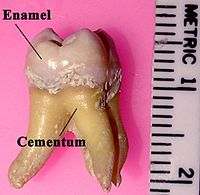
Photo from wikipedia
This study evaluated the effect of titanium tetrafluoride (TiF4) varnish on the development of dentin carious lesions. Bovine root dentin samples were treated for 6 h with: (A) 4% TiF4… Click to show full abstract
This study evaluated the effect of titanium tetrafluoride (TiF4) varnish on the development of dentin carious lesions. Bovine root dentin samples were treated for 6 h with: (A) 4% TiF4 varnish (2.45% F); (B) 5.42% sodium fluoride (NaF) varnish (2.45% F); (C) 2% chlorhexidine (CHX) gel – positive control; (D) placebo varnish; or (E) untreated – negative control (n = 4 × biological triplicate, n = 12). Treated dentin samples were exposed to human saliva mixed with McBain saliva (1:50) for the first 8 h in 24-well plates. Thereafter, the medium was removed, and McBain saliva containing 0.2% sucrose was applied for 16 h. From days 2 to 5, McBain saliva with sucrose was replaced daily (37°C, 5% CO2). The demineralization was measured using transverse microradiography, while the effect on biofilm was analyzed using viability, extracellular polysaccharide (EPS), and lactic acid production assays. The data were statistically analyzed (p < 0.05). All treatments (fluorides and CHX) significantly reduced the biofilm viability compared to placebo varnish and negative control. However, none of them was able to reduce the colony-forming unit counting for total microorganism, total streptococci, and Streptococcus mutans. NaF significantly reduced the number of Lactobacillus sp. compared to negative control. No effect was seen on lactic acid production neither on EPS synthesis, except that CHX significantly reduced the amount of insoluble EPS. Both fluorides were able to reduce dentin demineralization compared to placebo varnish and negative control; TiF4 had a better effect in reducing mineral loss and lesion depth than NaF. Therefore, TiF4 varnish has the best protective effect on dentin carious lesion formation using this model.
Journal Title: Caries Research
Year Published: 2019
Link to full text (if available)
Share on Social Media: Sign Up to like & get
recommendations!